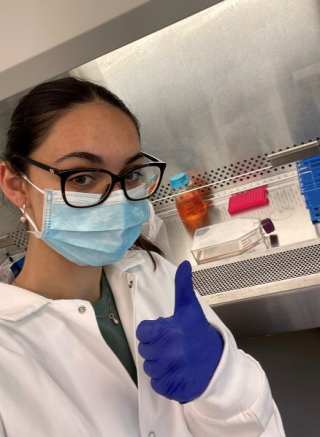Imagine being an undergraduate student and having the chance to investigate how immune cells overreact to make allergies worse. Or getting to explore a new way to create a better disinfectant.
For undergraduates who want to try their hand at research over the summer, there are plenty of opportunities through internship programs in the Faculty of Science. Far from merely carrying out grunt tasks, these interns get to work alongside graduate students conducting cutting-edge research in university labs.
There are over 100 Science Undergraduate Research Awards (SURA) given each year, up from 16 the first year they were offered, in 2007. There are also Natural Sciences and Engineering Research Council Undergraduate Summer Research Awards (NSERC USRA) and the possibility to perform research for credit, or even to try out research at a different faculty.
Not a linear process
Such internships are “a chance to see science in action, to appreciate that it is much less linear than the descriptions of discoveries in textbooks might have you believe,” says Judith Mandl, Associate Professor of Physiology and Canada Research Chair in Immune Cell Dynamics. She strongly believes students are never too young to learn “how much failure is a part of learning to become a scientist, and how rewarding it is when that key experiment you have been gearing up to actually works!”
Lisa Papara, U3 Physiology major, spent her summer in the Mandl Laboratory growing a type of immune cell – eosinophils --- to see what they respond to and interact with in bone marrow. When these cells work in overdrive, she explains, they can exacerbate the effects of allergies. But when they work well, they’re crucial to tissue repair.

“That’s the thing with most immune cells. If there’s too much of it, that’s a bad thing, if there’s too little of it, that’s also a bad thing,” Lisa says. “There needs to be a regulated state or otherwise they lead to all these crazy effects. That’s what’s so interesting about the immune system!”
Because eosinophils take longer to grow than most cells – at least 10 days -- Lisa had to be painstakingly consistent in creating growth protocols, so as not to lose time. “I’ve gotten familiar with microscopy technique, flow cytometry,” she says. Because her method was so successful “it puts the lab in a better position for any project they need to do moving forward.”
Problem-solving
Meanwhile in Professor Janine Mauzeroll’s chemistry lab nearby, Sascha Woolcott, U2 Bio-organic Chemistry major, was researching handy new molecular structures involving quatsomes, tiny vesicles that have innate anti-microbila properties. Those properties could enable quatsomes to be used in disinfectants that tackle bacteria-filled biofilms on surfaces.
With the pandemic’s uptick in disinfectant use in hospitals, the increased use of low-toxicity cleansers started to cause negative health effects in staff. A more effective cleanser could be used in lower concentrations, and so decrease exposure.

Sascha found lab research very different from classroom lab procedures, which are set up to work. “There’s a lot more problem-solving involved. You put more work into it, but it’s more satisfying when you get a positive outcome.” She loved seeing -- and learning from -- a wide variety of other projects in the lab. “You’re working with people who are the MOST specialized in their field, so you might as well use that opportunity to learn from them.”
Her supervisor, Professor Mauzeroll, finds undergraduate researchers have a lot to contribute. “They are consistently open, motivated and creative. They bring energy to graduate students and they ask fundamental questions that make you reconsider your view... Given enough freedom and time, undergraduate researchers can truly amaze you.”
‘A source of inspiration’
Lisa Papara was so taken by the work in the Mandl lab that she decided to take on an independent research project of her own this academic year, unusual for a major student. She’ll probably keep at the eosinophils and how they develop in bone marrow. Professor Mandl looks forward to seeing what Lisa will achieve. “It’s always a privilege and a pleasure to have undergrads participating in our work in the lab,” she says. “Seeing their excitement is a source of inspiration for me and my team.”

Lisa initially imagined her university trajectory leading towards medical school. Now she realizes that research is not sitting at a desk up to your eyeballs in papers, but instead offers great variety and freedom. “Everything’s always changing so it’s exciting. Especially for someone like me who likes when things are new. You’re always on your toes, you’re always thinking!”
For her part, Sascha wasn’t at all sure of her path when she started university. Her resolve now is to continue studying chemistry in grad school.
Seeing if research is for you
For students interested in a summer research project, Sascha recommends they approach professors early to get the ball rolling. And once working on a project, to not be intimidated by those with more experience. “You benefit a lot more from admitting when you do need help, and asking people questions, than you would if you always try and get through it on your own.”
Both Lisa and Sascha are from Ontario and loved being in Montreal in the summer. “It’s SO fun, there’s so much to do and a lot of my friends were around. And also to be able to stay on campus, do research and go to the lab every day, like a nine-to-five, but not have to worry about schoolwork,” Lisa says.
Lisa highly recommends summer research, especially to students who are not sure what they want to do. “Even if research may not be for you, you will learn indispensable skills that are applicable to any field,” she says. “And who knows, you might surprise yourself and fall in love with research by the end!”
